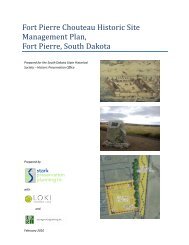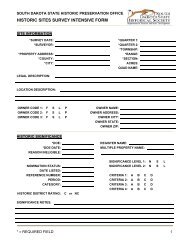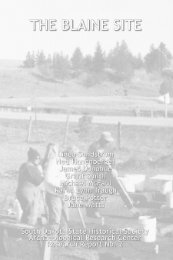A Geoarchaeological Overview of South Dakota and Preliminary
A Geoarchaeological Overview of South Dakota and Preliminary
A Geoarchaeological Overview of South Dakota and Preliminary
Create successful ePaper yourself
Turn your PDF publications into a flip-book with our unique Google optimized e-Paper software.
DRAFT DRAFT DRAFT<br />
a rich archaeological record (Labelle et al. 2003). In the <strong>South</strong>ern Plains, dunes develop on the<br />
downside edge <strong>of</strong> playas, creating a context where archaeological sites can be buried.<br />
Alluvial Environments<br />
Water flowing in streams provides energy for transporting sediment. The size <strong>of</strong> sediment particles<br />
varies with discharge. Fast flowing water has more energy <strong>and</strong> can move larger particles. The current is<br />
swiftest, <strong>and</strong> therefore sediments are coarser, on the channel bed <strong>and</strong> on the s<strong>and</strong> <strong>and</strong> gravel bars that<br />
flank it. As water rises higher <strong>and</strong> spreads farther from the channel, its velocity decreases, <strong>and</strong> coarse<br />
materials drop out, until eventually the water is carrying only fine s<strong>and</strong>s, silts, <strong>and</strong> clay. Alluvial<br />
environments are therefore divided into high energy environments where s<strong>and</strong>s <strong>and</strong> gravels accumulate<br />
on channel beds <strong>and</strong> bars, <strong>and</strong> low energy environments where finer particles are deposited from<br />
overbank floods. The high energy environments are unlikely to attract occupation or preserve<br />
archaeological deposits, but the low energy environments provide not only habitable surfaces, but the<br />
potential for sites to be buried as the floodplain surface slowly aggrades. Terraces, which are former<br />
floodplains ab<strong>and</strong>oned by downcutting <strong>of</strong> the stream, have the additional advantage (from the<br />
perspective <strong>of</strong> site formation <strong>and</strong> preservation) <strong>of</strong> being elevated above the active floodplain, <strong>and</strong><br />
therefore more protected from floods <strong>and</strong> erosion.<br />
Low-lying terraces, however, can be occasionally inundated by high magnitude overbank floods,<br />
resulting in the deposition <strong>of</strong> a veneer <strong>of</strong> younger alluvium over the original terrace surface. A terrace<br />
veneer is like an eolian mantle in being relatively thin <strong>and</strong> flat. The soil formed into the terrace fill is<br />
sometimes preserved under the veneer. Such veneers may occur on outwash terraces <strong>of</strong> rivers in the<br />
glaciated part <strong>of</strong> <strong>South</strong> <strong>Dakota</strong>.<br />
Investigations <strong>of</strong> Holocene valley sediments have been conducted throughout the state, including the<br />
Big Sioux River (Artz <strong>and</strong> Riley 2010, Lueck et al. 1988), Highl<strong>and</strong> Creek (Fredlund 1996); the<br />
Cheyenne River (Fosha 1992), the Gr<strong>and</strong> River (Brakenridge <strong>and</strong> McReady 1988), Bear Creek (Harksen<br />
1974), Sage Creek (Kowal 1997; Kuehn 2003), the White River (Hannus <strong>and</strong> White 1985), <strong>and</strong> the<br />
Missouri River (Coogan 1987; McFaul 1985, 1986).<br />
Low order valleys are small tributaries that are geomorphologically different from larger valleys in<br />
being narrower <strong>and</strong> more steeply graded. Because they are narrow, colluvial transport from the valley<br />
walls <strong>of</strong>ten has an important contribution to the valley alluvium, to the extent that alluvial (stream<br />
transported) <strong>and</strong> colluvial (slope transported) sediments are intermingled or interfingered with one<br />
another in the valley fill. Many low-order valleys have a predominantly erosional history, but others are<br />
broad enough to store sediment in terraces. In general, the more V-shaped a valley, the less buried site<br />
potential it has. Lower order valleys with U-shaped or flat cross sections have sufficient valley floor<br />
space to accommodate the storage <strong>of</strong> alluvial <strong>and</strong> colluvial sediment without it being flushed out by<br />
flooding <strong>of</strong> the stream.<br />
When lower order valleys store sediment, buried site potential is high. Wooded draws in the Missouri<br />
Trench are known to contain buried archaeological sites (Artz <strong>and</strong> Toom 1985; Toom <strong>and</strong> Steinacher<br />
1980). At Lighting Spring (Keyser <strong>and</strong> Davis 1984), the confluence at one locus <strong>of</strong> three small valleys<br />
resulted in the accumulation <strong>of</strong> 3 m <strong>of</strong> sediment in ca. 3500 years, with stratified, Late Prehistoric<br />
through Middle Archaic archaeological deposits throughout that thickness. Lange-Ferguson, a Clovis<br />
mammoth kill in the Badl<strong>and</strong>s (Hannus 1985) is another example <strong>of</strong> a highly significant archaeological<br />
site buried in small valley alluvium.<br />
Canyons in the Black Hills are different from valleys elsewhere in the state because they are highly<br />
constrained in width <strong>and</strong> depth by resistant bedrock. Steep, impermeable mountain slopes rapidly<br />
contribute run<strong>of</strong>f to streams, resulting in high energy stream flow that can transport large <strong>and</strong> abundantly<br />
available cobbles <strong>and</strong> boulders, in addition to s<strong>and</strong>s, silts <strong>and</strong> clays. Relatively thick alluvial fills with<br />
24

















